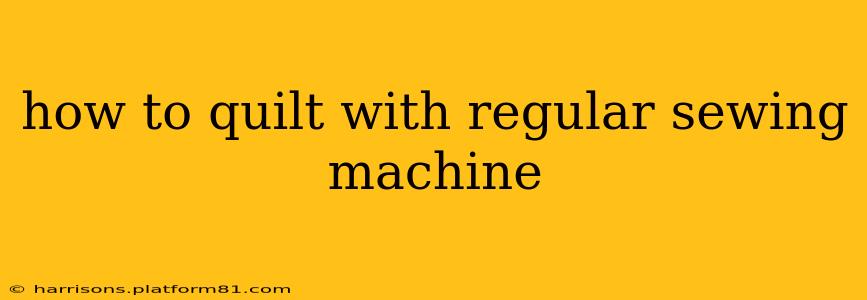Quilting, the art of stitching layers of fabric together, can seem daunting, but it's entirely achievable with a standard sewing machine! This guide will walk you through the process, answering common questions and providing tips for success. Whether you're a seasoned sewer tackling a new craft or a complete beginner, you'll find valuable information here.
What You'll Need to Quilt with a Regular Sewing Machine
Before you begin, gather these essential supplies:
- Sewing Machine: A basic machine will suffice. Ensure it's properly maintained and oiled.
- Quilting Cotton: This is a popular choice for its softness and easy handling. Choose fabrics that complement each other in color and pattern.
- Batting: This goes between the fabric layers. Cotton batting is a good starting point, offering a soft and manageable feel. Polyester batting is also popular for its durability and affordability.
- Backing Fabric: This fabric forms the back of your quilt. Choose a sturdy fabric that won't easily fray.
- Rotary Cutter & Mat: These tools are highly recommended for accurate cutting, especially for larger quilts.
- Ruler: A clear ruler helps with accurate measurements.
- Pins: Plenty of pins to secure the layers together. Quilting pins with ball-shaped heads are excellent for preventing fabric damage.
- Seam Ripper: Mistakes happen! Have a seam ripper on hand for quick fixes.
- Quilting Foot (Optional): While not strictly necessary, a walking foot or even a darning foot can significantly improve the evenness of your stitching, especially when working with multiple layers of fabric.
- Thread: Choose a strong thread that matches your fabric or contrasts for a decorative effect.
Choosing Your Quilting Pattern: Simple Designs for Beginners
Don't feel overwhelmed by intricate designs! Simple patterns are perfectly suitable for beginners. Here are a few ideas:
- Straight Lines: This classic pattern is incredibly easy to execute. Mark your lines with a fabric marker or chalk pencil.
- Diagonal Lines: Similar to straight lines, but adds a different visual appeal.
- Cross-Hatching: Creating a grid of intersecting straight lines.
- Meandering: Free-motion quilting, which requires a little practice to control the machine and create a consistent stitch. This is best attempted after you've mastered straight lines.
How to Prepare Your Fabrics for Quilting
-
Cut Your Fabric: Precise cutting is key. Use your rotary cutter and mat for accurate and efficient cutting. Ensure you have enough fabric for the quilt top, batting, and backing. Add extra fabric to account for seam allowances and shrinkage.
-
Layer Your Quilt: Lay your backing fabric face down, followed by the batting, and then the quilt top face up. Smooth out any wrinkles or bumps to ensure an even quilting surface.
-
Pin or Baste: Secure all three layers together using pins or basting. Basting is stitching a long running stitch to temporarily hold the layers together. This is crucial to prevent shifting during quilting.
How to Quilt with Your Sewing Machine: Step-by-Step
-
Select Your Stitch: Choose a straight stitch for simple designs or experiment with decorative stitches for more complex patterns. Adjust the stitch length to suit your fabric and project. A shorter stitch length will create a more durable quilt.
-
Begin Quilting: Following your chosen pattern (e.g., straight lines), begin stitching. Take your time and maintain a consistent speed. Move the fabric slowly and evenly.
-
Manage the Layers: Guide the fabric through the machine carefully, avoiding any bunching or pulling. If using a walking foot, this process will be significantly easier.
-
Stitch in the Ditch: A popular quilting method involving stitching in the seam lines of your quilt top piecing. This helps hold the layers together without adding visible quilting designs.
-
Binding the Quilt (Finishing): Once your quilting is complete, it's time to add a border. Cut strips of fabric and sew them around the edge of your quilt. After sewing, fold and stitch the binding down to the back of the quilt. This process is relatively involved, but numerous online tutorials can help you master it.
Troubleshooting Common Quilting Problems
- Fabric Bunching: Use more pins or baste the layers together to prevent shifting.
- Uneven Stitching: Check your machine tension and ensure you're feeding the fabric evenly. A walking foot can greatly assist in eliminating uneven stitching.
- Broken Needles: Use the correct needle size for your fabric. Replace the needle regularly.
H2: What type of sewing machine is best for quilting?
While a standard sewing machine will work, a machine with a larger throat plate and features like a walking foot or free-motion quilting capabilities will make the process easier and more efficient. However, don't feel you need to invest in a specialized machine to start quilting.
H2: What is the easiest quilting pattern for beginners?
Straight-line quilting is generally considered the easiest pattern for beginners. It's simple to execute and provides a clean, finished look. A simple cross-hatch pattern is another great beginner choice.
H2: How do I keep my layers from shifting while quilting?
Proper basting or pinning is crucial to prevent shifting. Use lots of pins or consider basting (sewing a long running stitch) your layers together before quilting.
H2: Do I need a special needle for quilting?
While a standard universal needle will often work, using a quilting needle designed for multiple layers of fabric will reduce breakage and improve the quality of your stitches.
With practice and patience, you'll master the art of quilting with your regular sewing machine. Enjoy the process, and don't be afraid to experiment! Remember to celebrate your successes along the way. This rewarding craft will bring you immense satisfaction.
